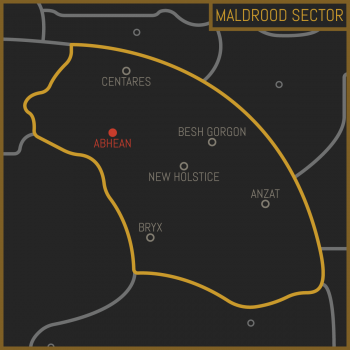Abhean (System)
| This article is a stub, meaning that is should be expanded.. You can help the Archives by adding to it |
| Abhean | |
|---|---|

| |
| Astrographical Information | |
| Sector | Maldrood |
| Galactic Coordinates | (285, 200) |
| Suns | Abhean Sun |
| Orbits | 3 Planets |
| Space Stations | 20 |
| Societal Information | |
| Date of Discovery | Before record-keeping began |
| Affiliation | Tresario Star Kingdom |
| Astrographic Entry | Abhean System |
The Abhean System is located in the Maldrood Sector controlled by Tresario Star Kingdom.
Contents
History
Politics
Economy
Planets
Abhean II
Astrographic entry: Abhean II
TBA
Abhean
Astrographic entry: Abhean
Abhean has a long and storied history of conflict going back over twenty-four millennia. It was on the frontline of the Tionese War, as the farthest forward major world of the Galactic Republic, and was captured by Tionese forces. The planet saw conflict again during the Second Alsakan Conflict in the mid-sixteenth millennium BCGT before becoming a major Republic Navy base by the dawn of the fifteenth millennium BCGT. During the Great Sith War at the start of the fourth millennium BCGT Abhean was the target of a major, successful raid by Mandalorian forces, and also witnessed conflict in involving Darth Revan's New Sith Empire. Abhean is the site of a major shipbuilding industry and boasts shipyards rivalling those of Sluis Van, although no Sluisi will admit to this. The shipyards even built the massive Jedi Praxium star vessel in Four Hundred BCGT. The planet's prominence has been accentuated by its location along the super hyper route known as the Perlemian Trade Route, which connects major economic nodes throughout this region of space.
Its location, as well as its proximity to the Siniteen homeworld, Sinite, are the major contributors to Abhean's continued prominence. Were it a more isolated world, the planet's geography, climate and atmospheric conditions would be quite inimical to life. Due to its distance from the system's star, average temperatures hover around twenty standard degrees below freezing. Icy winds, driven by the interaction of cold air from the permanent glaciers and hot air from the large active volcano belts, constantly whip up fine particles of ice and volcanic glass, which is ejected from the permanently active volcanoes. It is this airborne glass that makes Abhean's atmosphere toxic to life. Anyone not protected with suitable environmental equipment would not be able to avoid inhaling these shards with each breath and would swiftly suffer permanent lung injury and eventually death by drowning in their own blood within twenty-four to forty-eight hours.
As recently as the last century BCGT, the planet served as a training ground for the system's armed forces. Due to the relative concentration of the planet's inhabitants into domed and sealed cities, vast areas of the surface were available for military exercises, including actual orbital bombardments from the system defense fleet, as well as weapon manufacturers field testing new or improved shipborne weapons to be mounted on ships being constructed in the orbital yards. A significant number of shuttered or abandoned military facilities dot the icy surface and have been declared off-limits to anyone without government clearance. Rumors abound of secret weapons research facilities dug into secluded areas under the ice, but as yet these have not been substantiated by any credible sources.
Sinite
Astrographic entry: Sinite
Sinite is a cold, dry world, where most of the surface water is locked in glaciers and in the water storage roots of the many varieties of hardy trees that grow in some of the slightly less arid areas of the planet. Large regions of the planet are also covered in open lava fields and volcanic mudflats, where geysers of boiling sulphur-laden water erupt at regular intervals. Rivers of steaming mud flow for kilometres in all directions from the major geothermal centres, with the nutrients from the mud nourishing the forests of short trees and tall shrubs. Large areas of bare rock show where the more recent lava flows have cooled, forming a barren, black, fissured landscape for as far as the eye can see.
Despite this bleak landscape and the chilling wind perpetually blowing off the massive glaciers that gird Sinite, the planet boasts a thriving ecosystem. Forests of hardy trees and shrubs grow wherever the land forms valleys or depressions that can shelter them from the harsh winds, sending roots deep into the rock to search for water. Many of these plants have developed water-storing roots and bulbs that the local wildlife, especially the many species of small rodents, have learned to tap. The planet’s swirling winds, caused by the interaction between the hot air from the lava fields with the cold air from the glaciers, has ensured that no native avian or flying mammal species has evolved. Burrowing creatures abound to compensate, ranging in size from small mice as long as an index finger, to massive, carnivorous mole-rats the size of fully grown bantha. This has resulted in local building codes requiring that underground structures include duracrete walls and floors at least a metre thick to safeguard the inhabitants from a sudden influx of ravenously hungry giant rodents.
The native Siniteen have learned to take advantage of their planet’s topography and weather. Clean and renewable energy sources, such as geothermal power and wind turbine farms abound, ensuring minimal pollution. The Siniteen’s superior intellect has enabled them to site cities in the most advantageous locations, be they where hot vents allow for easy access for thermal power or near clean sources of underground water. This emphasis on clean technology also carries over to other sectors of the economy, making Sinite on of the most pristine of developed homeworlds and giving the Siniteen an edge in competing with similar goods produced on more heavily industrialized and polluted worlds – something Siniteen merchants are keen to public

